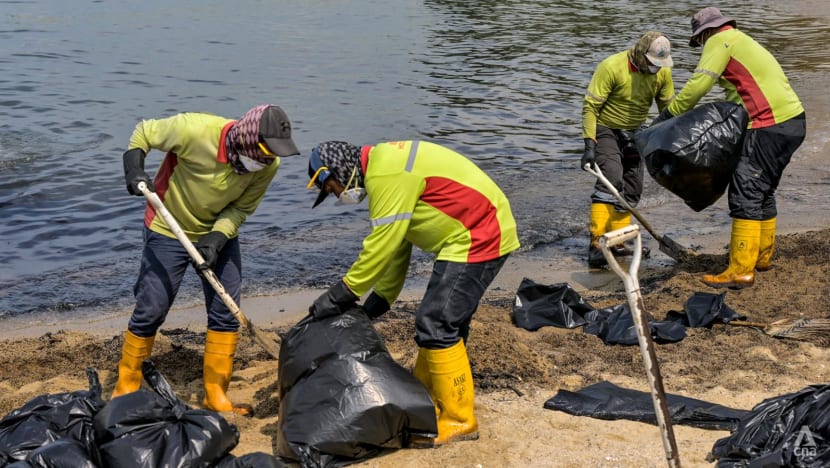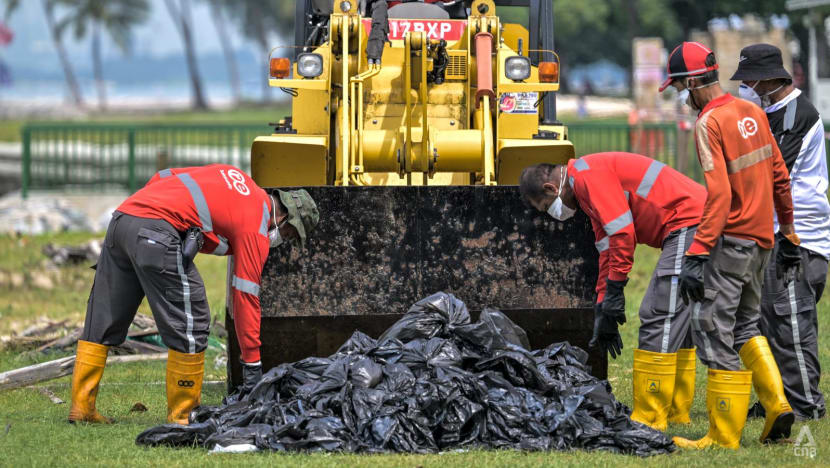N95 masks, gloves, shovels: How beaches at East Coast Park are cleaned up after an oil spill
About 100 workers are deployed daily to East Coast Park to clean up beaches affected by the oil spill.

Workers scoop oil-soaked sand into trash bags along the shoreline at East Coast Park. (Photo: CNA/Wallace Woon)

This audio is generated by an AI tool.
SINGAPORE: Wearing an N95 mask, yellow PVC safety boots and a pair of gloves, cleaning crew members armed themselves with shovels and trash bags as they laboriously scraped and scooped oil-soaked sand off the beaches of East Coast Park.
Large machinery such as excavators would occasionally shift larger piles of blackened sand into a pile so it is more easily collected.
It has been nearly a week since a Netherlands-flagged dredger, Vox Maxima, hit Singapore-flagged bunker Marine Honour at Pasir Panjang Terminal on Jun 14, causing an oil spill that stained several coastlines.
Among the beaches affected were areas B to H at East Coast Park, which have been closed until further notice.
About 100 workers are deployed daily by the National Environment Agency (NEA) to clean up the affected beachfront at East Coast Park, which stretches about 10km from Tanjong Katong to Tanah Merah.

COLLECTING, TRANSPORTING OIL-SOAKED SAND
In a media visit facilitated by NEA to area F of East Coast Park - near Bayshore Road - on Thursday morning (Jun 20), CNA saw about 30 workers scattered along the beaches.
The faint smell of petrochemicals occasionally wafted in with the sea breeze, while streaks of oil could be seen on the waters at the beach just west of Bedok Jetty.
Workers were first observed carefully scraping the oil-soaked sand with a shovel, forming the sand into a mound. They then shovelled the mound of sand into trash bags.


The rubbish bags of oil-soaked sand are then loaded by workers into a wheel loader that is stationed at the side of the beach.
A wheel loader is a heavy equipment machine used to scoop, lift and move bulk materials like soil, gravel, and sand, with a hydraulic arm.
The wheel loader then moves the bags of sand away from the beach to a lorry stationed deeper in the park, and the sand is unloaded into the lorry.

When the lorry is filled with bags, it will be driven to a licensed toxic industrial waste company for proper treatment.
To aid the cleaning crew, machines such as excavators and skid loaders are used to move sand along the beaches into large piles for workers to then shovel into bags.
Both the excavator and skid loader are a heavy equipment machine used for digging, excavating and moving materials like soil and sand around.
Unlike a wheel loader, an excavator and skid loader can travel on the sand because they move using tracks, which are continuous bands that wrap around wheels so the equipment can move on rough terrain such as sand.
The workers operate within daylight hours and take intermittent breaks under shelter.

BEACHES MOSTLY CLEARED OF OIL
In a joint statement on Thursday, Singapore's authorities said clean-up efforts by NEA are progressing well at East Coast Park and a "large majority" of oil deposits on the beach had been removed.
The beaches at Tanah Merah have also been largely cleaned up, while the beaches on three Singapore islands - St John's, Lazarus and Kusu - as well as a "large majority" of Sentosa's Siloso beach have been cleared of oily sand, they added.
The authorities noted that while the beaches at East Coast Park and Tanah Merah have been largely cleaned up, more effort would likely be required as the tides may continue to sweep in remnants of oil deposits.
Transport Minister Chee Hong Tat said on Thursday that it will still take "some time" before the oil is completely removed.
















